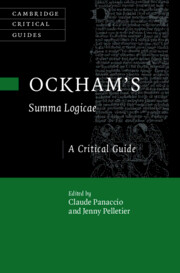Book contents
- Frontmatter
- Contents
- Contributors
- Abbreviations of Ockham’s Works
- Introduction
- Chapter 1 Metaphysical Methodology in Ockham’s Summa Logicae I
- Chapter 2 Ockham and Syncategoremata
- Chapter 3 Ockham on Metalanguage
- Chapter 4 Ockham’s Moderate Modism
- Chapter 5 Relations in Summa Logicae
- Chapter 6 The Threat of Pernicious Ambiguity
- Chapter 7 Ontology and Ockham’s Account of Truth Conditions for Tensed Propositions
- Chapter 8 Ockham’s Theory of the Categorical Syllogism
- Chapter 9 Ockham’s Modal Logic
- Chapter 10 Theory of Demonstration
- Chapter 11 The Obligationes of William of Ockham
- Chapter 12 Ockham on the Liar Paradox
- Chapter 13 Ockham on Figurative Discourse
- Bibliography
- Index
- Cambridge Critical Guides
Chapter 4 - Ockham’s Moderate Modism
Modes of Signifying in the Summa Logicae
Published online by Cambridge University Press: 04 September 2025
- Frontmatter
- Contents
- Contributors
- Abbreviations of Ockham’s Works
- Introduction
- Chapter 1 Metaphysical Methodology in Ockham’s Summa Logicae I
- Chapter 2 Ockham and Syncategoremata
- Chapter 3 Ockham on Metalanguage
- Chapter 4 Ockham’s Moderate Modism
- Chapter 5 Relations in Summa Logicae
- Chapter 6 The Threat of Pernicious Ambiguity
- Chapter 7 Ontology and Ockham’s Account of Truth Conditions for Tensed Propositions
- Chapter 8 Ockham’s Theory of the Categorical Syllogism
- Chapter 9 Ockham’s Modal Logic
- Chapter 10 Theory of Demonstration
- Chapter 11 The Obligationes of William of Ockham
- Chapter 12 Ockham on the Liar Paradox
- Chapter 13 Ockham on Figurative Discourse
- Bibliography
- Index
- Cambridge Critical Guides
Summary
At several points in the Summa Logicae, Ockham appeals to or relies on grammatical doctrines and terminology. One prominent example of this is his use of modes of signifying (modi significandi), which played a central role in a specific brand of speculative grammar whose proponents were known as “modists” (“modistae”). A central tenet of modism is that there is a correspondence between language and the world, mediated by thought, so that for every mode of signifying there is a corresponding mode of being. Ockham appeals to modes of signifying explicitly in at least three parts of his logic – fallacies, connotation, and synonymy – but his proclivity for ontological parsimony suggests that he would have had no fondness for the metaphysical commitments of modism. I argue that Ockham might be considered a “moderate modist” who denies the ontological excesses of modism but nonetheless utilizes much of its theoretical apparatus in his logic.
Keywords
Information
- Type
- Chapter
- Information
- Ockham’s Summa LogicaeA Critical Guide, pp. 85 - 104Publisher: Cambridge University PressPrint publication year: 2025
